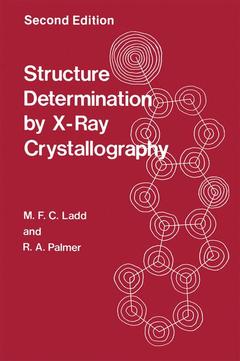Description
Structure Determination by X-Ray Crystallography, 1985
Authors: Palmer R.A., Ladd M.F.C.
Language: English
Subject for Structure Determination by X-Ray Crystallography:
Keywords
X-ray crystallography; chemistry; crystal; crystallography; mineralogy
Publication date: 05-2012
502 p. · 15.2x22.9 cm · Paperback
502 p. · 15.2x22.9 cm · Paperback
Description
/li>Contents
/li>
X-ray crystallography provides us with the most accurate picture we can get of atomic and molecular structures in crystals. It provides a hard bedrock of structural results in chemistry and in mineralogy. In biology, where the structures are not fully crystalline, it can still provide valuable results and, indeed, the impact here has been revolutionary. It is still an immense field for young workers, and no doubt will provide yet more striking develop ments of a major character. It does, however, require a wide range of intellectual application, and a considerable ability in many fields. This book will provide much help. It is a very straightforward and thorough guide to every aspect of the subject. The authors are experienced both as research workers themselves and as teachers of standing, and this is shown in their clarity of exposition. There are plenty of iliustrations and worked examples to aid the student to obtain a real grasp of the subject.
1 Crystal Geometry. I.- 1.1 Introduction.- 1.2 The Crystalline State.- 1.3 Stereographic Projection.- 1.4 External Symmetry of Crystals.- Problems.- 2 Crystal Geometry.II.- 2.1 Introduction.- 2.2 Lattices.- 2.3 Families of Planes and Interplanar Spacings.- 2.4 Reciprocal Lattice.- 2.5 Rotational Symmetries of Lattices.- 2.6 Space Groups.- Problems.- 3 Preliminary Examination of Crystals by Optical and X-Ray Methods.- 3.1 Introduction.- 3.2 Polarized Light.- 3.3 Optical Classification of Crystals.- 3.4 Direction of Scattering of X-Rays by Crystals.- 3.5 X-Ray Techniques.- 3.6 Recognition of Crystal System.- Problems.- 4 Intensity of Scattering of X-Rays by Crystals.- 4.1 Introduction.- 4.2 Path Difference.- 4.3 Mathematical Representation of a Wave: Amplitude and Phase.- 4.4 Combination of Two Waves.- 4.5 Argand Diagram.- 4.6 Combination of N Waves.- 4.7 Combined Scattering of X-Rays from the Contents of the Unit Cell.- 4.8 Structure Factor.- 4.9 Intensity Expressions.- 4.10 Phase Problem in Structure Analysis.- 4.11 Applications of the Structure Factor Equation.- 4.12 Preliminary Structure Analysis.- Problems.- 5 Methods in X-Ray Structure Analysis. I.- 5.1 Introduction.- 5.2 Analysis of the Unit-Cell Contents.- 5.3 Two Early Structure Analyses Revisited.- Problems.- 6 Methods in X-Ray Structure Analysis. II.- 6.1 Introduction.- 6.2 Fourier Series.- 6.3 Representation of Crystal Structures by Fourier Series.- 6.4 Methods of Solving the Phase Problem.- Problems.- 7 Direct Methods and Refinement.- 7.1 Introduction.- 7.2 Direct Methods of Phase Determination.- 7.3 Patterson Search Methods.- 7.4 Least-Squares Refinement.- 7.5 Molecular Geometry.- 7.6 Precision.- 7.7 Correctness of a Structure Analysis.- 7.8 Limitations of X-Ray Structure Analysis.- 7.9 Disorder in Single Crystals.- Problems.- 8 Examples of Crystal Structure Analysis.- 8.1 Introduction.- 8.2 Crystal Structure of 2-Bromobenzo[b]indeno[1,2-e]pyran (BBIP).- 8.3 Crystal Structure of Potassium 2-Hydroxy-3,4-dioxocyclobut-1-ene-1-olate Monohydrate (KHSQ).- 8.4 Concluding Remarks.- Problems.- A.1 Stereoviews and Crystal Models.- A1.1 Stereoviews.- A1.2 Model of a Tetragonal Crystal.- A1.3 Stereoscopic Space-Group Drawings.- A.2 Crystallographic Point-Group Study and Recognition Scheme.- A.3 Schoenflies’ Symmetry Notation.- A3.1 Alternating Axis of Symmetry.- A3.2 Notation.- A.4 Generation and Properties of X-Rays.- A4.1 X-Rays and White Radiation.- A4.2 Characteristic X-Rays.- A4.3 Absorption of X-Rays.- A4.4 Filtered Radiation.- A.5 Crystal Perfection and Intensity Measurement.- A5.1 Crystal Perfection.- A5.2 Intensity of Reflected Beam.- A5.3 Intensity Measurements.- A5.3.1 Film Measurements.- A5.3.2 Diffractometer Geometry and Data Collection.- A5.4 Data Processing.- A5.4.1 Introduction.- A5.4.2 Standard Deviation of Intensity.- A5.4.3 Absorption Corrections.- A5.4.4 Scaling.- A5.4.5 Merging Equivalent Reflections.- A5.5 Synchrotron Radiation.- A.6 Transformations.- A.7 Comments on Some Orthorhombic and Monoclinic Space Groups.- A7.1 Orthorhombic Space Groups.- A7.2 Monoclinic Space Groups.- A.8 Vector Algebraic Relationships in Reciprocal Space.- A8.1 Introduction.- A8.2 Reciprocal Lattice.- A8.2.1 Interplanar Spacings.- A8.2.2 Reciprocity of Unit Cell Volumes.- A8.2.3 Angle between Bravais Lattice Planes.- A8.3 X-Ray Diffraction and the Reciprocal Lattice.- A8.3.1 Bragg’s Equation.- A8.4 Laue Photographs.- A8.5 Crystal Setting.- A8.5.1 Setting Technique.- A.9 Intensity Statistics.- A9.1 Weighted Reciprocal Lattice.- A9.1.1 Laue Symmetry.- A9.1.2 Systematic Absences.-A9.1.3 Accidental Absences.- A9.1.4 Enhanced Averages.- A9.1.5 Special Distributions.- A.10 Enantiomorph Selection.- Solutions.
© 2024 LAVOISIER S.A.S.



